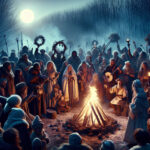Halloween is a beloved holiday celebrated around the world, but its origins remain shrouded in mystery. For centuries, people have questioned why and how this holiday came to be and whether it was originally a pagan holiday. In this article, we will explore the history of Halloween and uncover the truth behind its beginnings. We will look at the ancient pagan rituals that may have inspired the modern holiday, as well as the Christian traditions that evolved over time. By the end, you will have a better understanding of the origins of Halloween and how it has become the holiday we know today.

Halloween is a widely celebrated holiday with traditions that have been around for centuries. While it has become a popular holiday today, its roots stretch back to ancient times. The holiday has its origins in the pagan celebration of Samhain, one of the four seasonal festivals of the Celtic year. It is believed that the Celts believed that the boundaries between the living and the dead were weakened on this day, allowing them to celebrate the spirits of their ancestors and make offerings to them.
What is Samhain?
Samhain, pronounced “sow-in”, is a Gaelic festival that marks the end of the harvest season and the beginning of winter. It was celebrated from October 31 to November 1, the halfway point between the autumn equinox and the winter solstice. It was a time of transition when the Celts believed that the veil between the living and the dead was at its thinnest, allowing the spirits of their ancestors to visit the living world.
What did the Celts do for Samhain?
The Celts celebrated Samhain with bonfires, feasts, and offerings to their ancestors. They also wore costumes and masks to ward off evil spirits, and told stories of the past. They believed that the spirits of the dead could cause mischief and destruction, so they also performed rituals to protect their crops and livestock.
How did Samhain evolve into Halloween?
When Christianity spread throughout Europe, the pagan traditions of Samhain were adapted to fit the new religion. The Church declared that November 1 would be All Saints’ Day, or All Hallows, and the night before was known as All Hallows Eve, which eventually evolved into the modern term “Halloween”. The Church also adopted some of the pagan customs associated with Samhain, such as bonfires and costumes, and blended them with the celebration of All Saints’ Day.
What is the modern celebration of Halloween like?
Today, Halloween is celebrated with trick-or-treating, costumes, and parties. Many people also decorate their homes with jack-o-lanterns, ghosts, and other spooky decorations. While the roots of the holiday may be in pagan traditions, the modern celebration of Halloween has become a secular event that is enjoyed by people of all ages.
What is the significance of Halloween?
Halloween is a time to remember and celebrate the dead, and to recognize the importance of the spirit world in our lives. It is also a time to reflect on the cycle of life and death, and on the connection between the living and the dead. Ultimately, it is a time to celebrate the power of the human spirit and to recognize that life is full of mystery and wonder.
Halloween is a holiday that has been celebrated for centuries and has evolved over time. Initially, it was a pagan holiday that celebrated the end of the harvest season and the start of winter. Over time, the holiday has become more commercialized and associated with costumes, candy, and parties. However, the pagan roots of Halloween are still evident in its traditions and symbols. Despite its evolution, Halloween continues to be a time for celebrating the supernatural and honoring the dead. Ultimately, Halloween is a unique holiday that has stood the test of time and continues to be celebrated around the world.





